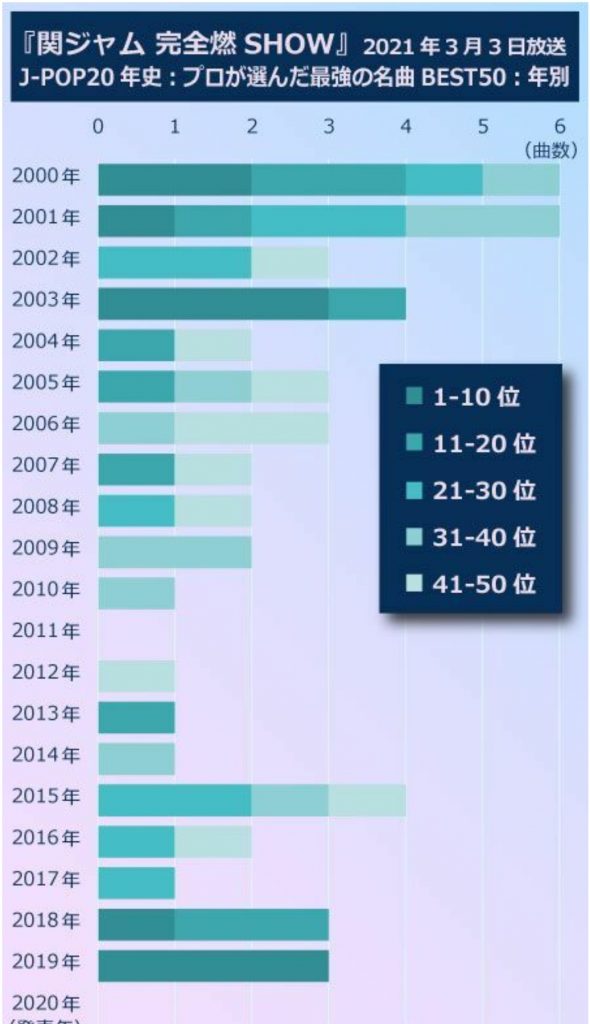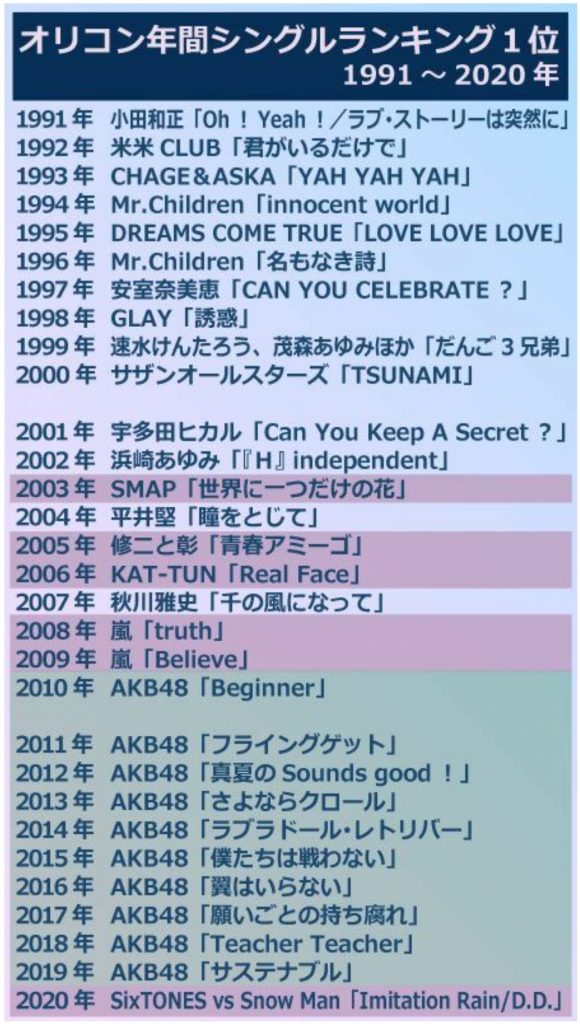The March 3 episode of “KanJam Kanzen Nen SHOW” centered on a ranking of the best 30 (in reality 50) JPop songs from 2000 – 2020. The group that came up with the ranking was composed of 48 music industry professionals, with a third of them being artists and the remaining portion being producers and composers. The ranking was based on a points system in which the each voter gives the top song 30 points, their second song 29 points, their third song 28 points, and so on.
Official HIGE DANdism‘s “Pretender”, still fresh in the public’s memory, topped the list. It was followed by SMAP‘s “Sekai ni Hitotsu Dake no Hana”, and MISIA‘s “Everything.” For many people, this is accurate.
For some, rankings on TV shows are hard to accept, in part because of entertainment politics, but this ranking was different. For instance, Kanjani8 was not featured in the ranking, even though they host “KanJam Kanzen Nen SHOW.” Ikimonogakari‘s Mizuno Yoshiki was a guest on this episode and none of his band’s songs were inlcuded either.
Because this list was created by music industry professionals, it is by no means in line with general public popularity. Take for instance the #16 song, “Aliens” by Kirinji. Even though it is the band’s signature song, it was not a hit with the public. The inclusion of this song makes it clear that this is a list created by music industry professionals.
2006 – 2015, the years not selected greatly
When watching the show, many people confused by the choices. This is in part because the years 2006 – 2015 were largely ignored. Most of the ranking was composed songs from the early 2000s and the last five years. The lack of songs from the years 2010 – 2014 was especially stark, with no songs from 2011 included at all, as shown below.

No songs from the first half of the 2010s made the ranking’s top 10. The highest ranking song from that period is AKB48’s “Koisuru Fortune Cookie”, released in 2013, which ranked at #11.
Based on this list, it can be said that the years 2006 – 2015 where ones where few music industry professionals saw masterpieces. But is this true?
“Chaku-Uta Full” hits in the latter half of the 2000s
Looking back at that time, the music industry changed drastically after the mid 2000s. From 2006 – 2015, it was difficult to see what was really a hit, due to people no longer relying only on CDs to listen to music.
An example of this is “Chaku-Uta” and “Chaku-Uta Full.” This was a service that allowed people to download song-derived ringtones and full songs, respectively, to their mobile phones. It spread from the mid 00s and was popular with young people until smartphones became commonplace.
Nishino Kana was big star of this era. Known as the “Keitai Generation Diva”, she made her debut with the “Chaku-Uta Full” release of “I ~Merry Christmas ver.~” in December 2007. She made her CD debut with the release of the regular version of “I” in February 2008. However, Kana’s only song on this ranking, “Torisetsu”, released in 2015, ranked at #43.
Also from this period is Kaela Kimura’s “Butterfly”, released in 2009, ranked at #38. It was released as a digital single, never as a CD single. It is widely known as a CM song for the wedding information magazine “Zexy” and is still popular today.
Oricon didn’t keep up with the ways in which music consumption was changing, instead choosing to rely on CD sales. The media continued to rely on Oricon and is dated ways because there was no alternative chart.
Because Oricon was behind the times and only counting CD sales, Kana’s “Aitakute Aitakute” ranked at #72 on the Oricon year end chart for 2010 with sales of 94,531; however, the song was certified Million for both “Chaku-Uta” and “Chaku-Uta Full.” Kaela’s “Butterfly” wasn’t even included in the Oricon year end chart for 2009 because it was never released as a CD single; however, the song was certified Triple Platinum (750,000) for both “Chaku-Uta” and “Chaku-Uta Full.” It was also certified Platinum (250,000) for PC Downloads, another full song download category at that time. In total, “Butterfly” had reached a million full song downloads by the end of 2009.
Oricon ranking of only AKB and Johnny’s
AKB48 sold millions upon millions of CDs during this period as a result of including handshake and general election tickets with its CDs. They had found a bug in Oricon’s system, which had become outdated, and used this portray the image that CD sales equal popularity. Called the “AKB Shoho (AKB Commercial Code)”, this was a strategy that took advantage of the turmoil created during this time of music industry transition.
Johnny’s acts also did very well on Oricon at this time due to the high purchasing power of its rabid fanbase. The company didn’t embrace digital downloads, so the only way to listen to their music was on CD.
Looking at the Oricon year end chart singles chart #1s from the past 30 years, it can be seen that from the mid 2000s forward, it’s nearly all AKB or Johnny’s. Johnny’s takes over in 2005, and AKB tops for the chart for the entirety of the 2010s.

Billboard, recovery of hits
Due to the dysfuctional ways of Oricon, Billboard began to gain attention in 2015. Unlike Oricon, which only counts CD sales, Billboard counts CD sales along with other measures, including digital downloads and streaming. It also frequently adjusts its chart formula.
Billboard embraces how music is listened to today. Now that streaming is mainstream, even songs that haven’t been released on CD, like YOASOBI’s “Yoru ni Kakeru”, are seen as big hits.
In the decade before Billboard came to prominence, it was unclear what was a hit. Music journalist Shiba Tomonori detailed this in his 2016 book “Hit no Houkai (Hit Collapse)”, and the “KanJam Kanzen Nen SHOW” ranking supports this. This uncertainty about what was a hit in 2006 – 2015 may have unconciously affected the decisions made by the music industry professionals who created the list.
Reconstructed “Lost Decade of JPop”
The years 2006 – 2015 were a time when music listening pivoted from CDs to the internet, via downloads, streaming and YouTube. AKB and Johnny’s sold millions of CDs during this time, which were regarded as hits by old-fashioned Oricon.
On the other hand, Nishino Kana sold millions of downloads during this time. KPop acts such as Girls’ Generation and KARA made full use of YouTube and expanded their popularity. Kyary Pamyu Pamyu, who made her major debut in 2011 with “PONPONPON“, went viral globally on YouTube with the music video for the song, at a time when it was rare for full JPop music videos to be on YouTube. This period was also the genesis of Yonezu Kenshi, who had gained attention using Vocaloid during this period, but would go on to dominance in the latter half of the 2010s.
Looking back like this though still seems like a disappointment. Oricon’s dated ways resulted in “the lost decade of JPop”, where hits were difficult to see.
These problems were well known to many music fans. An example of this is the music chart analysis site Billion Hits!, which is currently summarizing the download sales rankings since 2006 and verifying them year by year. In an article that looks back on the year end download sales for 2010, the popularity of Nishino Kana, KARA, and Girls’ Generation can clearly be seen. Billion Hits! isn’t a professional site, but a fan-created one. Asa, the site’s owner, is attempting to restore the memory of “the lost decade of JPop.”
People have different definitions of what a hit is, but if the hits can’t be seen, then JPop can’t move forward.
In 2021, Johnny & Associates is finally embracing the internet, while the popularity of the AKB48 group is unclear. That’s why now is the time to look closely at the past and rebuild the “lost decade of JPop.”
I realized while translating this that Arama! Japan is very much the English version of Billion Hits! Here are the Oricon Flashback year end posts that I’ve done over the years for “the lost decade of JPop”, which a focus on the digital charts / Billboard for those years, when available:
2006 (Oricon)
2007 (Oricon)
2008 (Billboard)
2009 (Billboard)
2010 (Billboard / RIAJ Digital Track Chart)
2011 (RIAJ Digital Track Chart)
2012 (Oricon)
2013 (Billboard)
2014 (Billboard)
2015 (Billboard)
A couple of notes:
The Billboard Japan Hot 100 wasn’t created until 2008. It’s not included here for 2011 and 2012 because I didn’t include it when I did Oricon Flashback for those years in 2016 and 2017, respectively. It will be included when I redo the 2011 and 2012 year end post at the end of this year and next year, respectively, since I’m doing 2011 this year in Oricon Flashback and 2012 next year.
The RIAJ Digital Track Chart existed from 2009 – 2012. It’s not included here for 2009 and 2012 because I didn’t include it when I did Oricon Flashback for those years in 2019 and 2017, respectively. It will be included when I redo the 2009 and 2012 year end post at the end of 2024 and next year, respectively, since I’m doing 2009 in 2024 in Oricon Flashback and 2012 next year.

Comments